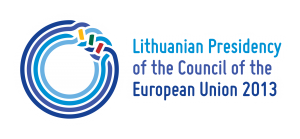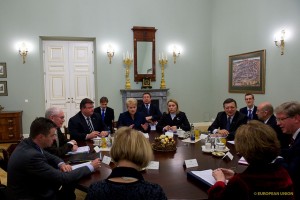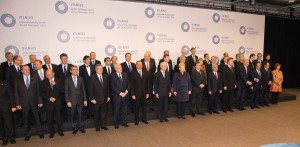 What is the Eastern Partnership Summit?
What is the Eastern Partnership Summit?
Eastern Partnership (EaP) Summits are held every two years (the first two took place in 2009 in Prague, Czech Republic; and in 2011 it was in Warsaw, Poland). During these meetings the course of the Eastern Partnership is discussed, the objectives for the next two years are determined, and the prospects for the future are drawn up. The results of the meeting are reflected in a Joint Declaration, which becomes the starting point for further development of the Eastern Partnership. The 2013 Summit took place in Vilnius on 28-29th of November.
What were the concrete results of the summit in Vilnius 2013?
- Initiation of the process of signing Association Agreements (AAs) and Deep and Comprehensive Free Trade Area (DCFTA) between the EU and Georgia and Moldova (expected to be signed in autumn 2014).
- A temporary postponement of signing the AA and DCFTA with Ukraine.
- The signing of a visa facilitation agreement between the EU and Azerbaijan.
- A proposal of the European Commission on a visa-free regime with Moldova.
- A joint Statement of the EU and the Republic of Armenia.
- An agreement on Georgian involvement in international missions of the EU.
If you would like to know more about these results, there was a compregensive article published on them on the website of the Lithuanian Presidency of the Council of the European Union (also called the Concilium or Council of Ministers).
Which main issues were raised?
The main focus of the summit was related to the refusal of Ukraine president, Viktor Yanukovych, to sign the AA. The EU was ready to retreat from the criticism of selective justice in the case of Yulia Tymoschenko, but Yanukovych rejected the signing of AA referring to inadequate financial aid to upgrade the Ukrainian economy and too severe financial losses in trade with Russia (for more information you can read this comprehensive Analysis). Dalia Grybauskaite, president of Lithuania, told reporters that the road Ukraine had chosen did not lead anywhere. However, the EU still keeps its door open for Ukraine and Ukrainian president told he was still committed to sign the AA “in the near future”.
Russia, although not EaP member, became an important part in the story of the Vilnius summit. Alexey Pushkov, the head of State Duma (lower house of the Federal Assembly of Russia) International Relations Committee, said that the EU had not succeeded in the ‘effort to isolate Russia’. He added one could expect more anti-government “Maidans” and continued EU support of Ukrainian opposition.
What do AA and DCFTA mean generally?
Association Agreements are international agreements that the EU has concluded with countries aiming to set up an all-embracing framework for bilateral cooperation. These agreements normally provide a progressive liberalisation of trade. In case of EaP countries, they do not guarantee a future membership of the EU (as there are also AA’s between the EU and non-European countries like Chile, Israel and South Africa). However, each country, nonetheless, negotiates an AA individually with the EU and there must be an intention to establish close economic and political cooperation and a privileged relationship between the EC and its partners.
Moreover, the state that has signed an AA is required to implement acquis communautaire of the EU (about acquis). This implementation covers a wide range of policies and rules for the country. The reason behind this is the need for similar or common rules within the single market. This might mean that the country has to undergo some painful reforms, which is why some countries have refused to sign and AA.
Deep and Comprehensive Free Trade Area, the DCFTA is included in the AA, but the free trade agreement has to be negotiated separately. It provides more advanced free trade zone between two or more countries. Traditionally, standard free trade agreements foresee a mutual opening of markets for goods and services. The reason that this agreement is called ‘Deep and Comprehensive’ is that it would go much further. It would be “comprehensive” because it would cover a wide array of trade-related issues and it would be “deep” because it aims to eliminate ‘behind the border’ obstacles for trade. So a DCFTA practically means a partial opening/extension of the EU’s internal market to the country signing the agreement (a case study of the Georgian DCFTA can be found here).
What do the AA and DCFTA mean for Georgia and Moldova?
F irstly, it has to be said that neither Georgia nor Moldova have already signed AA and DCFTA. At the summit in Vilnius just the process of initiating the signature took place and it is expected to be finished in the autumn of 2014. Then, however, the AA still needs to be ratified by all EU-member states, which is quite a time-consuming process. And in 2014 Moldovan parliamentary elections will take place with the possible win for the communist party whom favours trade with Russia, but it is not against the EU trade relations. So the course Moldova will take after the elections will also still be interesting to watch. In any case one can say that both, Georgia and Moldova have not yet arrived at the end of the road.
irstly, it has to be said that neither Georgia nor Moldova have already signed AA and DCFTA. At the summit in Vilnius just the process of initiating the signature took place and it is expected to be finished in the autumn of 2014. Then, however, the AA still needs to be ratified by all EU-member states, which is quite a time-consuming process. And in 2014 Moldovan parliamentary elections will take place with the possible win for the communist party whom favours trade with Russia, but it is not against the EU trade relations. So the course Moldova will take after the elections will also still be interesting to watch. In any case one can say that both, Georgia and Moldova have not yet arrived at the end of the road.
But today, both countries already enjoy a so called Generalized System of Preferences (GSP) in trade relations with the EU. The system offers limited preferences to the EU market. Once DCFTA comes into force, even the GSP, as well as various trade tariffs, will be abolished and these countries will enter a free trade area with the EU. Advantages of closer relations with the EU (even without prospect of full membership) are as following:
- DCFTA will encourage foreign direct investments into both countries, since both of them will share similar legislation according to European standards.
- From this point results that both countries will gain access to greater markets in the EU and therefore increase their trade exchange.
- Last but not least, citizens of both countries will get a variety of products and services that respect European standards of consumer protection and quality.
The most obvious objection against this closer cooperation with the EU is implementation of burdensome European regulations. It is sometimes a painful and costly process with short-term losses (as we had seen in case of Central and Eastern post-soviet countries before their accession into the EU), but it is weighted by long-term gains of stable and sustainable trade cooperation. At this point, the country and its leadership have to decide whether short-term costs are worth long-term benefits.
There are some obstacles as well. First, implementation of AA and DCFTA requires strong administrative capacities, which both countries have currently been lacking. The reform of administrative capacities is thus needed before the official signature. Second, Georgian and Moldovan governments do not control complete custom territory of their own. In Georgia, there are the separatist regions of South Ossetia and Abkhazia and in Moldova there is the region of Transnistria. In both cases, central governments do not hold state power over these regions and therefore the implementation of AA and DCFTA is questionable.
Will they be implemented in these regions, even if central government of Georgia and Moldova do not control them? How could we assure the same standards of goods and services from these regions? Will the products from these regions have the same access to the European market, even if these regions have strong trade ties with Russia? These questions have to be answered before the signing of the AA and DCFTA can take place.
Aims for the next summit in Riga 2015
- Finalizing the signature of the AA with Georgia and Moldova (most likely in 2014).
- Achieving visa liberalization.
- Enhanced cooperation in the areas of illegal migration, drugs- & human trafficking, organized crime, and corruption.
- Strengthen the cooperation in the area of research & innovation, public institutions, interpersonal contacts, and agriculture & countryside development.
- Implementation of common infrastructure projects and a harmonization of transport policy.
- Deepening the cooperation on energy security.
- Bigger involvement of the EU in frozen conflict areas (Nagorno-Karabakh, South Ossetia and Abkhazia and Transnistria).
- Support of multilateral projects and initiatives, cross-country cooperation, small and medium enterprises, and structured dialogue in foreign policy.
How much money is invested?
With the new Multiannual Financial Framework 2014-2020, the ‘European Neighbourhood Instrument’ becomes the main tool for supporting the EU Neighbourhood Policy. It has a total budget of more than €15 billion and covers 16 countries[1], amongst which there are six EaP countries. Apart from this main source of funding, there are several other instruments involved like the Neighbourhood Investment Facility, Cross Border Cooperation program, and the European Investment Bank.
What lessons can be learnt from the Vilnius summit?
Firstly that the Eastern Partnership does not show consistent results and secondly, the EU should find a way to counter the Russian influence in the EaP region.
The results are inconsistent as the two main fields of EaP influence can be seen in the economic/mobility area and in the political area. The EaP results are far more successful in the former than the latter. This is because the success of the influence on the political area (democracy, respect to human rights, rule of law and good governance) is dependent on the will of domestic leaders to converge to the European standards and values. This is certainly not the case, not all EaP countries want to share the same values as the EU and, therefore, the impact of EaP is limited in this field.
One of possible solutions is to grant a full membership to the EaP countries if they comply with the rules of the EU as was done in the past with post-communist countries in Central and Eastern Europe. Another possible solution is to use the principle “more for more” in a more consistent and persuasive way (the more you reform, the more rewards from the EU you get). This principle has not worked well in the past, because of rigid European investments in the region. Since 2012, however, one can observe more flexible usage of that principle from the EU.
The second lesson was about Russia. Russia has its security and energy interests together with a cultural proximity, making it a very relevant actor in the area. The current Russian approach reflects zero-sum game (you either win or lose, there is no win-win option for anyone involved), which is harmful for the development of EaP programme because these countries need to be able to cooperate with Russia as well as the EU.
The EU should, therefore, rethink its strategy towards Russia and work to persuade the courty to choose cooperation instead of competing for the “spheres of influence” in the region. The idea of holding trilateral talks (for example between the EU, Ukraine and Russia) was rejected by the EU politicians at the summit. However, the competing projects of Eastern Partnership (EU initiative) and of Eurasian Economic Community (Russian initiative) need to be resolved in a cooperative way for the sake of these six ex-Soviet countries.
In the end, the Vilnius summit raised more questions than it gave answers. Can the results of the meeting be evaluated as successful without the signing of the AA with Ukraine? Has the EU taken a “time-out” with its eastern neighbours? Or has this summit divided countries into two categories – the ones willing to cooperate further with the EU, and the others having stronger doubts and closer relations with Russia? Should the EU be more selective in dealing with its partners, or more open? How should the EU behave towards Russia? We cannot fully answer any of these questions today but, hopefully, we will see positive answers to some of them in the near future.
Written by: Ivan Bielik (Eastern Partnership Project)
[1] These countries are Algeria, Egypt, Israel, Jordan, Lebanon, Libya, Morocco, Palestine, Syria, Tunisia, Armenia, Azerbaijan, Belarus, Georgia, Moldova and Ukraine.
Useful websites for further reading
- Euractiv – http://www.euractiv.com/search/apachesolr_search/vilnius%20summit
- Russia Today – http://rt.com/search/everywhere/term/vilnius+summit/
- Al Jazeera – http://www.aljazeera.com/Services/Search/?q=vilnius%20summit
- Euro|topics special edition about Ukraine – http://www.eurotopics.net/en/home/debatten/links-2013-11-ukraine/
- Carnegie Europe – http://carnegieeurope.eu/search/?fa=searchResults&qry=vilnius+summit
- Russian view of Vilnius summit – http://english.pravda.ru/world/ussr/29-11-2013/126275-eastern_partnership_summit-0/


